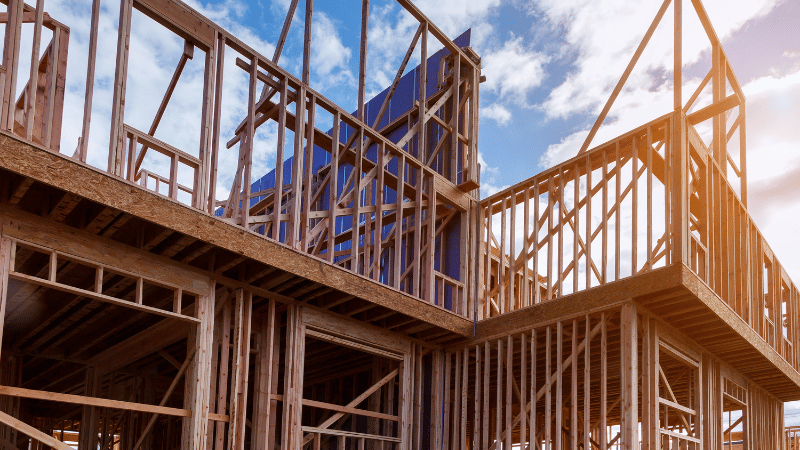Imagine walking into a beautifully renovated building. Everything looks immaculate and you cannot wait to enjoy this space, but then you start to feel sick. It feels as though you have a low-grade fever, a bad migraine, shortness of breath and you start to feel itchy. Those with Multiple Chemical Sensitivities (MCS), allergies, children or the immune suppressed may develop mild to severe adverse health effects to new construction. If you’re a host dealing with new construction or recent renovations, managing off-gassing from building materials and finishes is crucial for ensuring a healthy environment for your guests. Off-gassing refers to the release of volatile organic compounds (VOCs) from materials such as paint, adhesives and flooring, which can impact indoor air quality. Here are some key health concerns associated with new construction:
1. Off-Gassing
What It Is: Off-gassing refers to the release of volatile organic compounds (VOCs) and other chemicals from building materials, finishes and furnishings.
Health Effects:
- Respiratory Issues: VOCs can irritate the respiratory system, causing symptoms such as coughing, wheezing, and shortness of breath.
- Headaches and Nausea: Exposure to VOCs can lead to headaches, dizziness, and nausea.
- Long-Term Effects: Prolonged exposure to certain VOCs has been linked to chronic respiratory conditions and potentially even cancer.
Sources:
- Paints, varnishes and sealants
- Carpets and adhesives
- Composite wood products (e.g., plywood, MDF)
2. Dust and Particulate Matter
What It Is: During construction, dust and fine particulate matter are released into the air from materials like drywall, wood and concrete.
Health Effects:
- Respiratory Problems: Inhalation of construction dust can cause or exacerbate respiratory issues, such as asthma and bronchitis.
- Allergic Reactions: Dust can trigger allergic reactions, including sneezing, itching and watery eyes.
Sources:
- Drywall sanding
- Cutting and sawing of wood and other materials
3. Mold and Moisture Issues
What It Is: Inadequate drying or poor moisture management during construction can lead to mold growth.
Health Effects:
- Respiratory Issues: Mold spores can irritate the lungs and exacerbate asthma and allergies.
- Skin Irritation: Mold exposure can cause skin rashes and irritation.
Sources:
- Poor ventilation during construction
- Water leaks or inadequate drying of materials
4. Chemical Residues
What It Is: Some construction processes involve chemicals that can leave residues, which may persist even after construction is completed.
Health Effects:
- Chemical Exposure: Residual chemicals can cause irritation and health issues similar to those caused by off-gassing.
Sources:
- Cleaning agents and solvents
- Pest control chemicals used during or after construction
5. Poor Ventilation
What It Is: New buildings or recently renovated spaces may not have adequate ventilation systems in place immediately.
Health Effects:
- Indoor Air Quality: Poor ventilation can lead to the accumulation of indoor air pollutants, including VOCs, dust, and moisture.
- Health Symptoms: Poor indoor air quality can result in headaches, dizziness, fatigue, and other symptoms.
Sources:
- Incomplete or improper HVAC system installation
- Lack of proper air exchange
6. Electromagnetic Fields (EMFs)
What It Is: The installation of electrical systems and wireless devices can increase exposure to electromagnetic fields.
Health Effects:
- Sensitivity Issues: Some individuals report symptoms of electromagnetic hypersensitivity (EHS), such as headaches, fatigue and sleep disturbances.
Sources:
- Electrical wiring and appliances
- Wireless technology and smart devices
7. Physical Hazards
What It Is: New construction sites might have physical hazards that could cause injury.
Health Effects:
- Accidents and Injuries: Improperly managed construction sites can pose physical risks to occupants and workers.
Sources:
- Unsecured construction materials
- Inadequate safety measures during and immediately after construction
Preventive Measures
To mitigate these health risks, consider the following steps:
- Green Building Supply: is a company specializing in healthier, environmentally friendly and sustainable building materials that can be purchased. The company focuses on offering products that minimize environmental impact, improve indoor air quality, low to no VOCs, healthier alternatives and, overall, promotes healthier living and working spaces.
- Choose Low-VOC and Non-Toxic Materials: Opt for materials that are low in VOCs and free from harmful chemicals and use non-toxic products when cleaning. Consider using natural finishes like linseed oil or natural waxes that have minimal off-gassing compared to synthetic finishes. For flooring consider choosing flooring materials that are low in VOCs, such as bamboo, cork, or certain types of engineered wood. Carpets can trap VOCs and are harder to keep clean. If carpets are necessary, opt for those made from natural fibers with low-VOC adhesives. Select adhesives and sealants that are low in VOCs to minimize off-gassing.
- Ensure Proper Ventilation: Use fans and open windows to improve air circulation and reduce the concentration of pollutants. Ensure good cross-ventilation by opening windows and using exhaust fans. This helps to expel indoor air pollutants and bring in fresh air. Consider installing an air exchange system that continuously brings in fresh outdoor air while expelling indoor air.
- Allow Adequate Curing Time: Allow new materials to off-gas and dry completely before occupying the space. Ideally, aim for a curing period of at least 2 weeks or more after construction or renovation. After applying new finishes or installing new materials, ensure that the space is well-ventilated. Open windows and use fans to help disperse VOCs.
- Regular Cleaning: Clean surfaces and air filters regularly to reduce dust and residues. Perform regular cleaning of surfaces, floors and furniture to remove dust and other contaminants that may accumulate.
- Monitor Air Quality: Use air quality monitors to keep track of indoor air pollutants and take action if necessary. Use air purifiers to help clean the air and improve the indoor air quality. Invest in air purifiers with HEPA filters to remove airborne particles and activated carbon filters to capture VOCs and odors. Place air purifiers in key areas, such as bedrooms and living spaces to improve air quality.
- Address Moisture Issues: Ensure proper moisture control and ventilation to prevent mold growth.
- Consult Professionals: Work with professionals to ensure proper installation and maintenance of ventilation and HVAC systems.
- Inform Guests: Be transparent and let guests know that you had new construction done and have taken measures to ensure a healthy environment, such as, minimizing off-gassing and improving air quality.
- Certification Programs: If possible, choose materials and methods that are certified by green building programs like LEED (Leadership in Energy and Environmental Design) or other reputable environmental certifications.
By addressing these factors, you can help create a healthier environment for occupants and minimize the potential negative health impacts of new construction. Managing off-gassing in new construction or renovation is essential for providing a comfortable and healthy environment for your guests. By selecting low-VOC materials, ensuring proper ventilation, using air purifiers and keeping the space clean, you can effectively reduce the impact of off-gassing. Additionally, being transparent with your guests about the steps you’ve taken can enhance their comfort and trust in your property.

